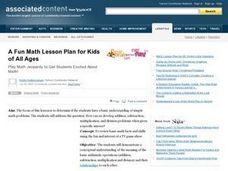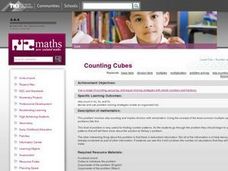Curated OER
Subtraction: Decimals
In this decimal subtraction learning exercise, students solve 15 problems that require them to subtract decimal numbers with 1-5 digits.
Curated OER
Jack Math Scramble
Students practice throwing and catching jacks to improve their hand-eye coordination. In groups, they participate in a variety of games in which they use the jacks to improve their problem solving skills. To end the lesson, they pick up...
Curated OER
The Fathers' Day Card
Students subtract using decimals and find half of a decimal number. They write and solve problems which involve decimals and which require a choice of one or more of the four arithmetic operations.
Curated OER
My Dogs
Learners use the properties of multiplication to solve problems. They recall the basic multiplication facts as well as write and solve problems that involve whole numbers.
Curated OER
Partial Quotients
Fifth graders examine the partial-quotients algorithm for finding the answer to a division problem. In this partial quotients lesson, 5th graders demonstrate the process of division through a series of estimations. Students examine the...
Curated OER
Math Jeopardy
Students play a game to practice concepts and principles that can be adapted to any subject.
Curated OER
Math Jeopardy
Students, in teams, play Math Jeopardy against each other as a way to reinforce their skills.
Curated OER
Big Magic Squares
Students discover that magic squares are interesting objects in both mathematics proper and in recreational mathematics. So they are objects that students should have heard about and experienced.
Curated OER
Counting Cubes
Students count backwards in 2s from 30 then try other skip patterns such as 1,3,5, etc. and invent their own counting patterns. They are introduced to the problem using a pile of cubes and count by 2s and have a remainder.










